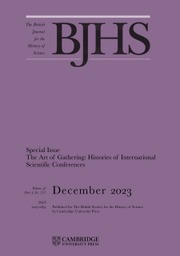In The Graft Hybrid, Holmes's interpretation of grafting is broad – from hens with transplanted ovaries to in vitro cell fusion. But the material covered all points to the idea that grafting is analogous to forming offspring through sex if the resultant organism can express heritable traits from both scion and stock. So, can they? Holmes presents one-off oddities, uncertain progeny and irreproducible methods that suggest an alternative history of heredity, one in which lateral gene transfer defies basic Mendelian principles. The book argues (1) that grafted hybrids interfered with an orthodox theory of genetics that limited inheritance to sex cells, (2) that debates about the nature of heredity lasted throughout the twentieth century and (3) that experimentation with graft hybrids became affiliated with Lysenkoism in the Soviet Union.
Holmes opens with the concept of the Weismann barrier, dating to the late nineteenth century, which posits a partition between sex cells and somatic cells. Scientists would soon extend heredity material beyond the nuclei of sex cells, but not beyond sex cells themselves. Holmes summarizes the rediscovery of Mendel and development of chromosome theory before introducing the Soviet agronomist Trofim Lysenko. Lysenko rejected the Mendelian theory of inheritance as antithetical to communist values. Holmes argues that of all of Lysenko's anti-capitalist ideas, graft hybrids posed the most trouble for classical genetics. Lysenkoism became synonymous with pseudoscience during the Cold War, yet Holmes convincingly shows that not all biologists discredited the Soviet's stance on hybridization via grafting. One fascinating detail in the book is that Lysenko displayed wax models of graft hybrids at a lecture to the Russian Academy of Sciences. These simulacra are representative of the questionable evidentiary basis for graft hybrids, a theme throughout the book.
Rewinding from this Cold War backdrop, Chapter 1 starts with William Bateson popularizing Mendel's ideas and ousting somatic cells from theories of heredity. One experiment with chickens challenged the newfound genetic ‘laws’. When the American physiologist Charles Guthrie cross-transplanted the ovaries of a black leghorn and a white leghorn hen, both purebred birds hatched chicks with mixed plumage. Whatever mechanism contributed to the hereditary shuffle could not be attributed to sex cells. Geneticists disputed Guthrie's findings. William Castle attempted the same experiment with albino and black-furred guinea pigs and interpreted the results in terms of Mendelian dominance. Perhaps Guthrie's foster hens had regenerated their own ovaries? The subsequent debate regressed into matters of technical error and doubts about the ancestry of experimental animals.
The next chapter discusses chimeras. When cells of two organisms do not fuse but intertwine to resemble a single organism, a chimera forms. On the surface, chimeras appear indistinguishable from hybrids, but not when observed under a microscope. Holmes explains how Mendelians begin to expose graft hybrids as mere chimeras. The one plant accepted as a true graft hybrid based on chromosome count got lost during the First World War. Again, evidence for somatic fusion resulting in hereditary change was contentious at best. Chapter 3 returns to the hypothesis that organisms could acquire heritable characters. A Viennese zoologist professed to have induced a lineage of toads to grow and inherit extra padding on their forelegs by manipulating vivarium conditions. He also transplanted the ovaries of spotted and striped salamanders to create offspring that displayed both patterns. Corroboration proved problematic and led to heated allegations. When it came to grafting species, few scientists had the technical skills to succeed, and those who did faced paradigmatic disapproval.
In Chapter 4, ‘Beyond Lysenko’, Holmes shows that geneticists with communist sympathies in the United States and United Kingdom, including J.B.S. Haldane, read Lysenko's work charitably. Despite Marxist leanings, however, experiments provided nothing to substantiate the philosophical appeal of graft hybrids. Human error offered a more compelling explanation, as did amendments to Mendelian doctrine. Anyone familiar with the Lysenko story will be rewarded by reading this chapter and the next. Chapter 5 continues chronologically into the Cold War to showcase personal collaborations between British scientists and those from the communist bloc (Czechoslovakia, China and Yugoslavia) who began to study graft hybrids in research on immunology. Holmes conveys obscure findings with an admirable fluency and presents the concept of ‘covert science’ to encapsulate the research zeitgeist (p. 144).
The final body chapter follows biotechnology into the 1980s to argue that the promise of somatic hybridization, a technique for fusing plant protoplasts, was overshadowed by recombinant-DNA technology. A shortage of chemicals needed to strip plant cells of their cell walls limited research on somatic hybrids: the culture methods were technical nightmares and the hybrids mostly infertile. Holmes attributes the ascendance of recombinant DNA to its wide applicability in molecular biology, whereas somatic hybridization stayed ‘the preserve of plant scientists’ (p. 180). Here, Holmes invites the reader to contemplate the extent to which contingency affected research with graft hybrids. In this sense, The Graft Hybrid can be understood within the counterfactual research programme of Gregory Radick, asking what changes unfold in teaching and research if Mendelism had not been crowned as rightful historical victor. The book concludes with a vindication of sorts. Recent research has found genetic hybridization to occur in grafted plants. Holmes sees the repercussions as wide open.
The book will be of interest to any historian of the biological sciences. I did find it striking that Holmes dealt so little with grafting as a horticultural pastime. Holmes moves the narrative between grafting varieties and grafting species, as if these were equivalent events. Does grafting apples on cold-hardy rootstock ‘bear the stamp of Lysenko’ in the same way as these other terminal curiosities? (p. 130) The unpredictability of graft hybrids is much to blame for whatever difficulties attend their discussion, as is the old species definition. Holmes succeeds in reframing somatic fusion as a topic of lasting importance in the history of twentieth-century genetics. Not to be ignored, The Graft Hybrid marks a new junction for studies of its kind.



